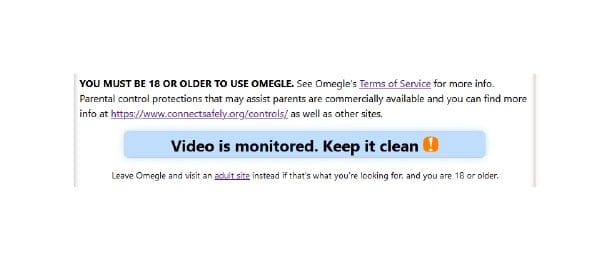CYBERTIP.CA RECEIVES INCREASE IN REPORTS OF CHILDREN EXPOSED TO SEXUAL VIOLENCE ON OMEGLE
The Canadian Centre for Child Protection (C3P) wants to make parents aware of an increased number of reports about Omegle, a website that enables randomized video and text chats between users.
Omegle’s tagline is self-explanatory; people visit the site to “Talk to Strangers.”
Two check boxes are all that stands between youth and a stream of chat rooms filled with strangers who can seemingly do whatever they want. One check box signals that the user is 18 or older, while the second box acknowledges the user has reviewed and agreed to Omegle’s Terms of Service, Privacy Policy, and Community Guidelines. Neither of these check boxes prevent someone under 18 years old from entering the website and are quick to execute.
The site randomly pairs anonymous users in one-on-one chat rooms without asking for any identifying information. Users can enter into text chats, or video chats that combine video and chat functions.
THE STATISTICS ARE ALARMING
- On average over the past year ending June 2023, Cybertip.ca, Canada’s tipline for reporting the online sexual exploitation of children, has received a report about Omegle every two days.
- Compared to 2021-222, reports have risen by 122%; compared to 2018-193, reports have increased by 397%.
- Of the 180+ reports, 120+ involved concerns about someone communicating with a child for a sexual purpose through Omegle. The remaining reports were about users allegedly sharing child sexual abuse material through the platform.
WHAT IS EVEN MORE ALARMING
- Several reports to Cybertip.ca explained that Omegle users requested and obtained information to connect with the youth outside of Omegle, such as their social media username or their phone number.
- Based on these and other Cybertip.ca report information, it appears users are meeting youth on Omegle then moving the communication to a different platform.
What are the risks parents should be aware of?
1. Reporting process
While users can report any sexual violence they experience on Omegle, reporting is not that easy to locate. C3P analysts could not find any buttons to report to Omegle in text chats, video chats, and unmoderated video chats.
Users have to first visit the site’s landing page and review the Community Guidelines. In the fourth paragraph of the Community Guidelines, users are directed to email sa****@****le.com and include “Omegle-Safety” in the subject line to report concerns. These instructions are followed by this statement: “While Omegle is not responsible to you as a user for enforcing these Community Guidelines, reports of violations are helpful to Omegle.” This statement leaves the impression that reporting may not result in action.
That said, Omegle does state that they ban users temporarily or permanently if they are inappropriate or harmful. C3P analysts could not find details on Omegle’s website about the process Omegle follows before banning users.
2. Lack of age verification

- while Omegle introduced a new 18+ age minimum to use their site nine months ago4, youth can access the website by clicking three buttons and saying they are over 18.
- Omegle is a website accessible without restriction from any device with a web browser, unlike an app in a mobile app store which may restrict downloads based on the age of the user.
3. Exposure to harmful content
- Omegle notes that “Video is monitored,” but does not provide further information about what it monitors or how, or its moderation processes.
- Users can choose to enter the “Unmoderated section” if they check a box, acknowledging this portion of the website is unmoderated.
|
|
- Whether in the monitored or unmoderated section, exposure to sexual content can occur. For example, Omegle displays ads for pornography websites, “cam sites5,” and other sexual services.
- Also, links to adult pornography can be sent by strangers in text and video chats.
- While visiting Omegle, C3P analysts on the platform were sent links to 18+ websites in text chats, shown a still advertisement for a pornographic website through video chats, and encouraged to navigate to different platforms to “continue conversations.”

|
- C3P analysts also found on the “monitored” text and video chats, users may still be exposed to sexual content, which includes being asked sexual questions, being sent links to content displaying sexual acts, such as masturbation, and being encouraged to engage in sexual acts.
|
|
4. Users targeting youth
- As on many other social media platforms and live streaming services, Omegle users have the opportunity to groom youth and manipulate youth into sharing private information and sending intimate images and videos.
- Any image or video sent by youth can be captured as a screenshot or video, putting youth at risk of sextortion.
Parents can help mitigate risk online. Here’s how:
- Block the website from devices your child accesses
- Omegle is not intended for children and there are no parental control settings on Omegle that you could enable to make the site safe for youth to use. You can block the website completely. These settings will be different for each browser, but the steps can be found here.
- Talk to your kids about the risks they face online:
- Explain that Omegle has a minimum age requirement of 18 years old, and does not have safety features intended to protect youth from seeing sexual or violent content.
- Talk to your youth about the risks of video chatting, including that anyone watching can capture a screenshot or video without them knowing. For tips on getting the conversation started around chatting online, visit the risks page on ProtectKidsOnline.ca™.
- Encourage your kids to talk to you about weird or uncomfortable situations they encounter online. Emphasize that it is never too late to come to you for help, even if they feel like they have made a mistake.
If you see, read, or hear anything sexual from an adult towards your child online, report it to Cybertip.ca or law enforcement.


